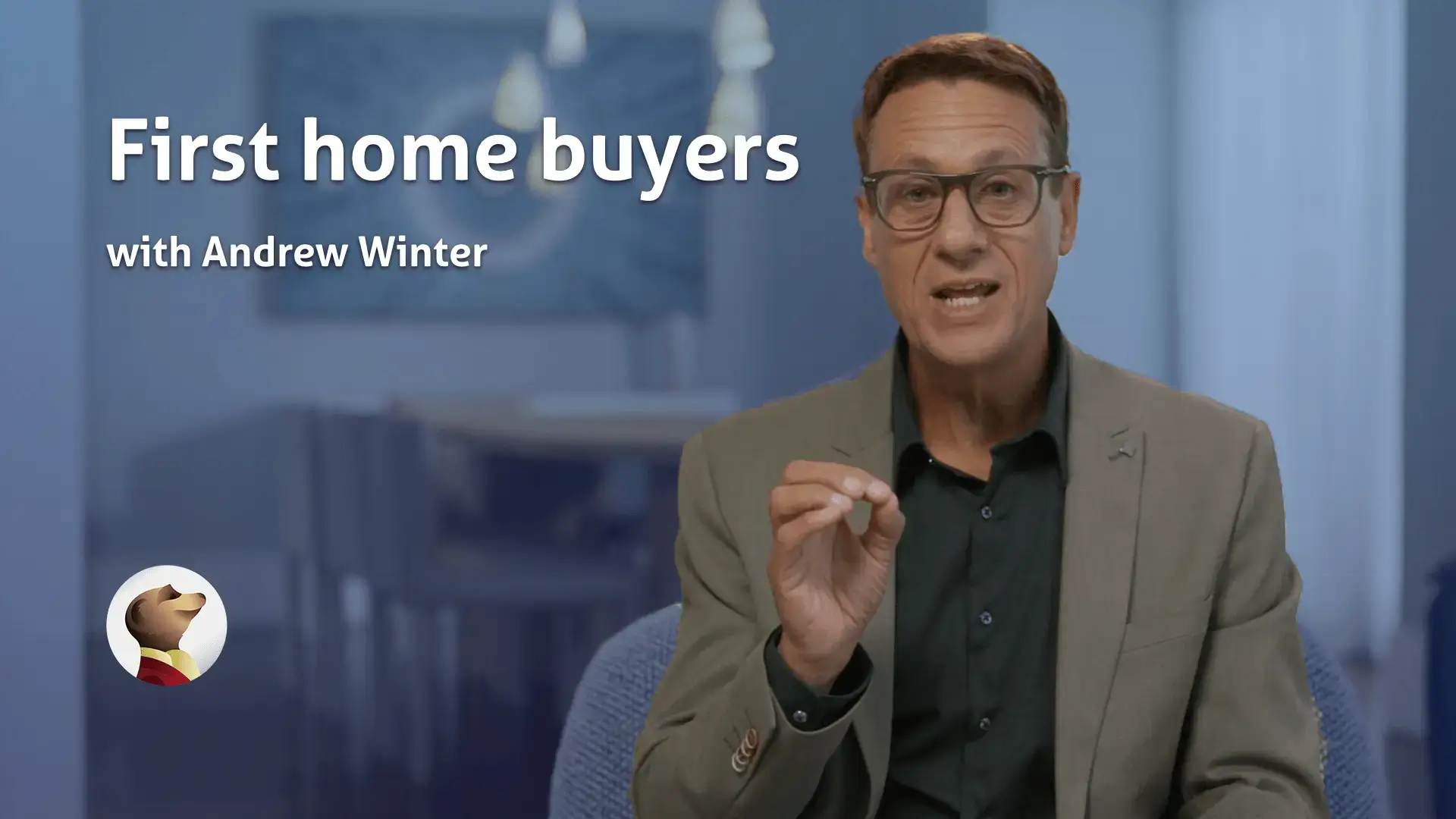Home / Home Loans / Using superannuation for…

Key takeaways
- The First Home Super Saver Scheme (FHSS or FHSSS) can help first home buyers build a home deposit faster by accessing their voluntary super contributions
- The FHSS comes with strict withdrawal limits and eligibility requirements, so be sure to check whether you’re eligible before applying
- You may also want to consider the pros and cons of accessing your super before doing so, as well as the potential tax ramifications of making a lump sum withdrawal
Tips for first home buyers



Hi, I’m Andrew Winter, host of Selling Houses Australia.
I’ve bought, and helped people buy, a lot of homes, but there’s nothing quite like
your first is there?
And yet, while buying a home for the first time is a tremendous accomplishment, getting
there can be a long and strenuous ordeal.
Navigating the various legal and financial hurdles can be a real stress point; let alone
saving your home loan deposit in the first place.
So, to try and save you all a little trouble, here are three essential tips for first home
buyers to keep in mind.
The first is to check what kinds of government assistance you might be able to call upon.
Stamp duty exclusions, cash grants, deposit guarantees; there’s a wide range of initiatives
at both the state and federal levels designed to help you Australians buy their first home.
The second is to make sure you’ve got a clear understanding of what your homebuying
costs will be beyond and outside of your home loan.
Stamp duty, conveyancing costs, application fees; these things can really start to add
up if you haven’t budgeted for them.
That makes it key to do your research and identify your potential homebuying costs ahead of time.
Otherwise, you risk putting a real squeeze on yourself come buying time, which could
have potentially disastrous consequences.
My third and final tip is that you absolutely need to compare your options, to make sure
that when it comes to your home loan, you’re getting the best, not the rest.
So if your gearing up to start house hunting
remember to start loan hunting as well with Compare the Market.
Expert tips for using your super for a home deposit
Our General Manager of Money, Stephen Zeller, wants to make sure that prospective homebuyers are making an informed decision when considering accessing their superannuation to build a home deposit. With that in mind, he has some tips:

Start crunching the numbers
If you’re looking to start building up the amount you’d have available for withdrawal you’re your super, set a budget and a realistic goal so you know how much you’ll have available to contribute via the scheme at your chosen point in time.
Understand the tax benefits
If you’re consistently making concessional (i.e., pre-tax) voluntary super contributions, saving up part of your deposit within your super fund could save you a decent chunk of change in income tax.
Buying with a partner?
You and your partner could potentially both decide to utilise the scheme, and combine your saved funds into one deposit or part-deposit to increase your borrowing power.
First Home Super Saver Scheme explained
The FHSS scheme is a government program that is administered at the Federal level by the Australian Taxation Office (ATO). It was introduced in 2017 and gives Australians another way of building up a home deposit by essentially using their super accounts as deposit savings accounts.
It allows eligible first homebuyers to access the voluntary contributions they’ve made into their super account up to a maximum amount of:
- $15,000 in eligible contributions from any single financial year
- $50,000 in eligible contributions across all years.
The FHSSS does not allow for the release of any portion of your superannuation balance which is not made up of voluntary contributions. This means that any mandatory superannuation guarantee payments made into your superannuation account by your employer will not be available for release.
The pros and cons of using your super to buy a house
While gaining access to your voluntary super contributions can be an invaluable tool for prospective first homebuyers, there are numerous risks that can come with dramatically reducing the balance of your superannuation account. That being said, everyone’s financial circumstances and priorities are different, so we’ve laid out the major pros and cons of a superannuation home deposit to try and help you make a more informed decision on whether this is right for you.
| Pros | Cons |
|---|---|
|
|
Applying for the First Home Super Saver Scheme
First Home Super Saver Scheme eligibility

To request a FHSS determination (a ruling on your eligibility for the scheme that you must receive before applying for any release of your super contributions) you’ll need to:
- Be 18 years of age or older
- Have not owned property in Australia before of any kind
- Have not made a previous FHSSS release request under the FHSS scheme.
The FHSSS is also only available to those seeking to purchase residential property; those wanting to buy an investment property will not be eligible.
The FHSSS’ financial hardship provision
Depending on your financial situation, you may be eligible for the FHSSS even if you’ve previously owned property in Australia. If you’ve lost ownership of a property due to financial hardship, you can request a FHSSS determination, but you must apply to be considered under the financial hardship provision first.
The eligibility criteria for financial hardship consideration requires evidence of a link between the loss of your property and the hardship event in question. Some examples of potential hardship events mentioned by the ATO include bankruptcy, divorce, loss of employment, natural disasters and illness, but other causes of hardship may be deemed valid.
How do I access my super savings via the FHSSS?
In order to have your voluntary contributions released under the FHSSS, you’ll need to:
1. Check with your super fund
You’ll need to double-check that your superannuation fund will let you withdraw your voluntary contributions under the FHSSS.
2. Submit a request to the ATO for a FHSSS determination
You’ll have to do this via the ATO online services section in the myGov system. When you submit your request, the ATO will tell you the maximum FHSSS release amount, and inform you of whether you’ve been determined to be eligible for the scheme.
It’s important to note that while you can only request the release of your funds once, you can request to be deemed eligible to release your funds as many times as you like. So, if your initial request is unsuccessful, or is successful but you end up not accessing your super, you’ll be able to submit a request for another determination later on if you wish.
If you’re determined to be eligible for the FHSSS, you can proceed with the next step!
3. Submit a release request for your super savings
You’ll also do this using your myGov account via the ATO section again. Before submitting a release request, you may want to double-check the details contained within the FHSSS determination you received from the ATO, as any incorrect amounts or errors listed on the determination could see the release of your funds either delayed or cancelled by the ATO.
4. Receive your released amount
If your request is approved, the ATO will request the stipulated amount from your super fund. They will send it to you minus the appropriate amount of tax and the balance of any outstanding Commonwealth debts you might have, and plus any associated earnings the contributions attracted from your super fund.
After you receive your funds, you’ll typically have 12 months to find a property to purchase; however, this period can be extended if needed. It’s worth noting that your funds could take up to 25 business days to be released, so you won’t want to sign any contracts of sale or make any offers on a property until you’ve received your FHSSS amount.
You’ll also receive an end-of-financial-year payment summary for your released FHSSS amount, which you will need to include on your tax return for the year. The ATO has more information on how to do this and how the amount will be treated as part of your assessable income for the year.
Important information about using the FHSSS
Will I get taxed on the money I withdraw from my super?

Whether your super contributions are taxed upon withdrawal will generally come down to what type of contributions you’ve made into your super. Any before-tax contributions (e.g. those made under a salary sacrifice arrangement) you’ve made into your super will typically be taxed upon withdrawal, as will any deemed earnings released as part of your release amount. After-tax contributions will typically not be taxed a second time upon release.
The ATO applies a uniform tax treatment to amounts released under the FHSSS, which is either:
- Your marginal tax rate, including the 2% Medicare levy and minus a 30% offset
- 17% if the ATO cannot confidently predict your expected marginal tax rate for the year
Can I use super to make up 100% of my house deposit?
While you could hypothetically put together the amount required for a house deposit using nothing except your released super amount, you may subsequently find it difficult to be approved for a home loan.
This is because lenders will look for evidence of good financial habits and an ability to consistently save money when assessing someone’s home loan application. If you don’t have evidence of what lenders call ‘genuine savings’ (i.e. a decent sum that you’ve saved up the old-fashioned way), they may not view you as a suitable lending prospect.
What are voluntary super contributions?
Voluntary super contributions are any personal contributions you’ve made to your super account beyond the mandatory super guarantee, which is taken out of your regular pay pre-income tax.
You could make regular voluntary super contributions in a few different ways, including:
- As part of a salary sacrificing arrangement with your employer
- In the form of post-tax (i.e. your take-home pay) personal contributions (these are known as non-concessional contributions)
- Contributions made by your spouse into your super account (these are commonly referred to as spousal or spouse contributions)
Meet our home loans expert, Stephen Zeller
Stephen has more than 30 years of experience in the financial services industry and holds a Certificate IV in Finance and Mortgage Broking. He’s also a member of both the Australian and New Zealand Institute of Insurance and Finance (ANZIIF) and the Mortgage and Finance Association of Australia (MFAA).
Stephen leads our team of Mortgage Brokers, and reviews and contributes to Compare the Market’s banking-related content to ensure it’s as helpful and empowering as possible for our readers.
Want to know more about home loans?
1 Australian Taxation Office. First home super saver scheme. January 2024.
2 Australian Taxation Office. Tax on super benefits. January 2024.


